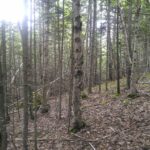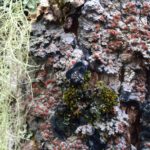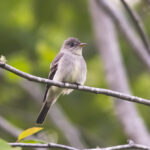Extending across North Mountain Ridge
01 Nov 2024
The steeply forested slopes of our North Mountain Ridge focus area in Inverness County host intact mature forest and a diverse range of thriving wildlife. Conservation efforts (including ours) have focused on the south side of the mountain, where long and narrow parcels of land stretch from the shore of the Bras d’Or up the slope to the plateau above. A newly protected property extends protection to the north side of the ridge, adding 81 acres (33 hectares) to the growing assemblage.
The property is adjacent to the provincially protected Little Beaver Lakes Nature Reserve, and to other land already protected by the Nature Trust. As we continue to build on assemblages of protected land like this one, we reduce the threats to the entire protected system and create safe corridors for wildlife to move between habitats – an especially important consideration as systems change and adapt in response to climate change.
Like much of the land in this focus area, the thick hardwood and mixedwood forest rises from extremely steep terrain, with near-vertical drops in places. In fact, this challenging terrain has likely protected these forests from significant harvest and allowed these ecosystems to thrive and mature. Several species at risk, including Blue Felt Lichen, Eastern Wood-Pewee and several other at-risk birds, are found on the property.
The protected lands in this area target one of the Nature Trust’s six primary conservation priorities: saving Nova Scotia’s old, unique, and significant forests. This property was supported by the Nature Smart Climate Solutions Fund, which aims to reduce Canada’s greenhouse gas emissions by supporting projects that reduce the loss, restore, or improve the management of ecosystems with powerful climate solutions potential, including old forests. Protecting these systems not only provides nature-based solutions to climate change, but also strengthens the resilience of these ecosystems, secures important habitat for multiple species of conservation interest, and benefits human well-being.

This project was undertaken with the financial support of the Government of Canada through the federal Department of Environment and Climate Change.



